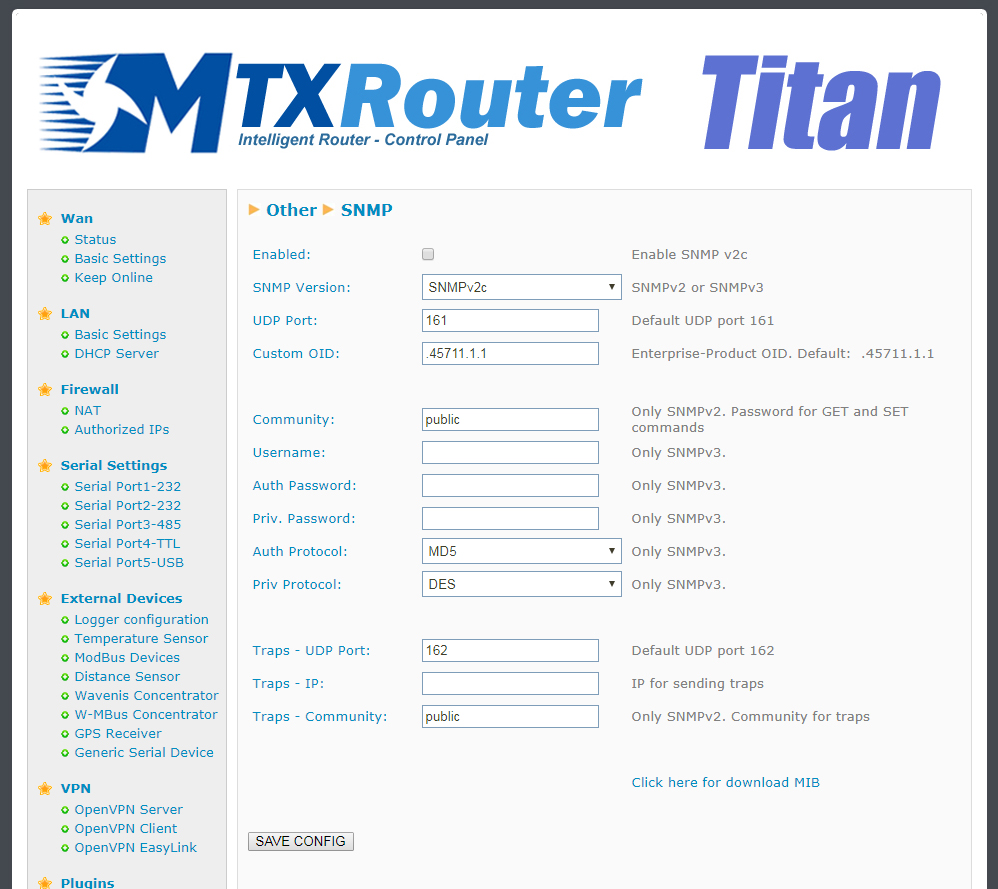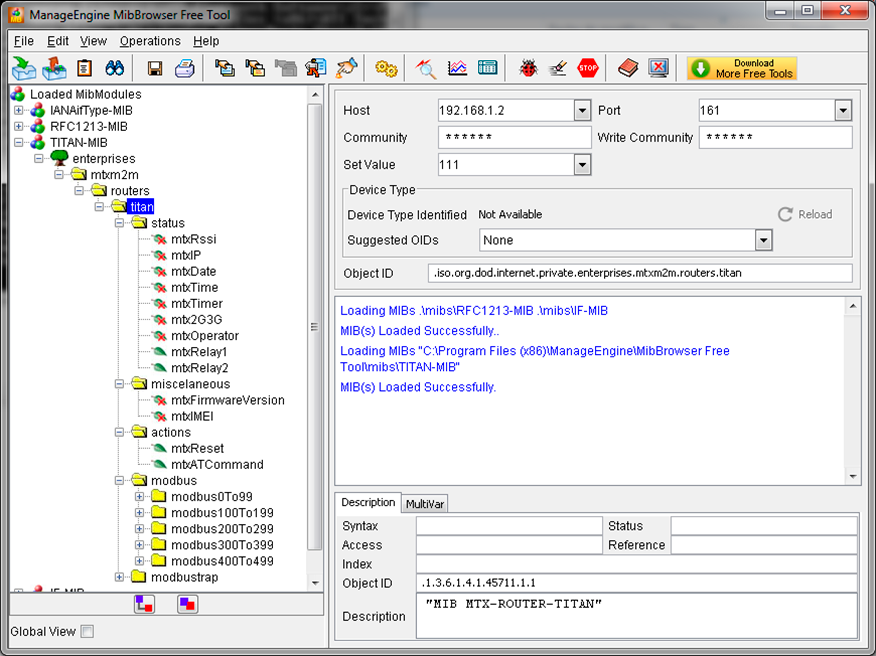Suchen Sie etwas anderes?
Titan routers include SNMP protocol for firmware versions 1.11 or later. Via SNMP we can carry out SET and GET operations from standard SNMP applications.
- Enabled: select this box if we wish to activate the Titan router’s SNMP service
- SNMP Version: SNMPv2 or SNMPv3
- UDP port: the standard UDP port for SNMP is 161, but this can be changed here
- Custom OID: this option allows we to change the Enterprise-Product OID of the default value (.45711.1.1) if we wish to tune this to our business values
- Community: the password required to execute SET and GET commands. Only necessary for SNMPv2
- Username: only necessary for SNMPv3
- Auth Password: autentication password for SNMPv3
- Priv Password: privacy password for SNMPv3
- Auth Protocol: autentication protocol (MD5 or SHA)
- Priv Protocol: encryption protocol (DES, AES128, AES192, AES256)
- Traps – UDP port: this option allows we to specify the port for SNMP Traps
- Traps – IP: the IP address for sending SNMP Traps
- Community: community field for sending Traps

ADDITIONAL NOTES
- Once the configuration is complete, press the “SAVE CONFIG” button to save the changes. Remember that the router should be reset in order for the changes to take effect.
- On the previous screen we can see a link with the text “Click here for download MIB”. Download the file to obtain the MIB with the OIDs.
- Using SNMP we can monitor the router. We can request information from the router such as the RSSI (network coverage), the time and date, the up time, whether it is working in 2G or 3G mode, the network operator being used, etc. We can also find out the status of the router relays, as well as change their statuses. The same is possible with digital inuts and pulse counters.
- An interesting option can be found in the section “Action”. Here we will see that two actions are possible. Firstly, we can reset the router remotely. Secondly, we can execute an AT command remotely via SNMP (writing in the corresponding register will excute the AT command and reading the register will obtain the response). Sending AT commands allows we to carry out any action using SNMO from reading a Modbus device that is connected to the router to changing configuration parameters or reading the GPS position.

- There is an Application Note regarding the use of SNMP and Traps, where we can find further examples of their applications and obtain a greater understanding of their capabilities:
AN8-Router-Titan-Modbus-to-SNMP-Gateway.pdf



 Enter the “ethernet” or “modem” connection type:
Enter the “ethernet” or “modem” connection type:
 For an ethernet configuration, make sure the IP parameters are compatible with server access according to the concentrator local network configuration. For an ethernet connection, the configuration must be compatible with the concentrator’s local network topology so that it can access the servers. This configuration is done from the “Networks” configuration page (see section 3.2.2.3: “Networks”).
For a modem connection, the modem configuration must be correct before a connection can be set up. This configuration is done from the “Modem” configuration page (see section 3.2.2.4: “Modem”).
The parameters for the servers to be configured are at least the following:
For an ethernet configuration, make sure the IP parameters are compatible with server access according to the concentrator local network configuration. For an ethernet connection, the configuration must be compatible with the concentrator’s local network topology so that it can access the servers. This configuration is done from the “Networks” configuration page (see section 3.2.2.3: “Networks”).
For a modem connection, the modem configuration must be correct before a connection can be set up. This configuration is done from the “Modem” configuration page (see section 3.2.2.4: “Modem”).
The parameters for the servers to be configured are at least the following:
 Therefore the following fields need to be configured: “Interface”, “Type”, “Server type”, “Address”, “Port”, “Login” and “Password”.
The other fields can be left at the default values subject to the directories having been properly created beforehand. See section 3.1.2: “Configuration files” for more details.
Therefore the following fields need to be configured: “Interface”, “Type”, “Server type”, “Address”, “Port”, “Login” and “Password”.
The other fields can be left at the default values subject to the directories having been properly created beforehand. See section 3.1.2: “Configuration files” for more details.




 Wait. The concentrator will reboot using its factory configuration.
Wait. The concentrator will reboot using its factory configuration.







